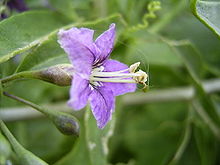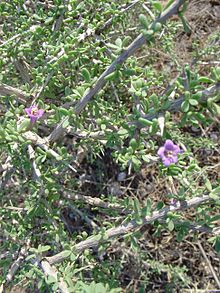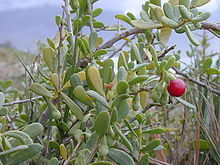- Boxthorn
-
Boxthorn 
African Boxthorn (Lycium ferocissimum) Scientific classification Kingdom: Plantae (unranked): Angiosperms (unranked): Eudicots (unranked): Asterids Order: Solanales Family: Solanaceae Subfamily: Solanoideae Tribe: Lycieae[1] Genus: Lycium
L.[2]Species About 90, see text
Synonyms Cantalea Raf.
Evoista Raf.
Jasminoides Duhamel
Oplukion Raf.
Panzeria J.F.Gmel.
Teremis Raf.[2]Boxthorn (Lycium) is a genus of the nightshade family (Solanaceae), containing about 90 species of plants native throughout much of the temperate and subtropical zones of the world. They are mostly found in dry, semi-saline environments.
Other common names include desert-thorn, Christmas berry, wolfberry, Matrimony vine, and Duke of Argyll's tea tree. Goji is a common English name made popular by several American-made juices and dried berries sometimes branded as "Tibetan" or "Himalayan" goji berries, although these terms do not geographically represent where the berries actually originate.
There are ~20 species in North America, ~30 species in South America, ~30 species in Africa, ~10 species in Eurasia, and one species in Australia. Grabowskia and Phrodus join Lycium in the tribe Lycieae, and are the genera most closely related to boxthorn.
The generic name is derived from the Greek word λυκιον (lycion), which was a name applied by Pliny the Elder (23-79) and Pedanius Dioscorides (ca. 40-90) to a plant known as dyer's buckthorn. It was probably a Rhamnus species and was named for Lycia, the province in which it grew.[3]
Contents
Description
They are long-lived, perennial, thorny shrubs, with deciduous alternate, simple leaves 1–8 centimetres (0.39–3.1 in) long. The flowers are solitary or in small clusters, 6–25 millimetres (0.24–0.98 in) diameter, with a corolla of five purple, white or greenish-white petals joined together at their bases. The fruit is fleshy, multiseeded berry 8–20 millimetres (0.31–0.79 in) diameter that may be red, yellow, orange, purple or black. These fruit resemble nightshade and bittersweet berries. In some species called wolfberries or "longevity fruit" (notably L. barbarum and L. chinense), the fruit is edible.
Most species of Lycium are cosexual (all flowers have both male and female function), however, several species exhibit sexual dimorphism. Evidence suggests that sexual dimorphism has evolved more than once in the genus. There are species that have both monoecious and dioecious populations, most notably L. californicum.
Uses
The plant has been known to European herbalists since ancient times and was traded from the Far East to Europe by the Romans already, for example via Ariaca and the port of Barbarikon near today's Karachi, as mentioned in the Periplus of the Erythraean Sea. In his Naturalis historia, Pliny the Elder describes boxthorn as a medicinal plant recommended as a treatment for sore eyes and inflammation, as does Pedanius Dioscorides in his P. Dioscoridae pharmacorum simplicium reique medicae.[4]
Boxthorn is mentioned in the biblical Book of Proverbs as besetting the paths of the wicked (Proverbs 22:5). In his 1753 publication Species Plantarum, Linnaeus describes three Lycium species: L. afrum, L. barbarum, and L. europaeum[4].
The fruit, leaves[verification needed], and bark of certain species have been used in China throughout more than 2,000 years of recorded history. Wolfberries are known in China as gǒu qǐ zǐ (枸杞子), and are processed into herbal teas, soups, juices, and alcoholic beverages. The bark is also used, it is known in Chinese as dì gǔ pí (地骨皮).
The berries may also be used whole; in traditional Chinese medicine they are always cooked, boiled either by themselves or in combination with other herbs; or as an ingredient in a soup. Whole wolfberries are used in this way for a variety of purposes in traditional Korean medicine and traditional Tibetan medicine, where boxthorn is called dre-tsher-ma ("ghost thorn"). It is a rare ingredient in kampō (traditional Japanese medicine), where the fruit is called kukoshi (クコシ) and the bark jikoppi (ジコッピ); these terms are derived from the Chinese names.
Ecology
Due to its ecologial requirements, boxthorns may be useful as a crop in arid regions. However, at least African Boxthorn (L. ferocissimum) has shown to be able to spread uncontrollably and become an invasive weed in Australia.
Lycium species are used as food plants by the larvae of some Lepidoptera species including Coleophora vigilis (recorded on L. ferocissimum).
Selected species
- Lycium acutifolium
- Lycium afrum L.
- Lycium ameghinoi
- Lycium amoenum
- Lycium andersonii – Anderson Boxthorn, Anderson Thornbush, Anderson Wolfberry, Anderson Desert Thorn, Desert Tomato, "tomatillo"
- Lycium arenicola
- Lycium australe F.Muell.
- Lycium barbarum – Duke of Argyll's Teaplant, Ningxia Wolfberry, "wolfberry"
- Lycium bosciifolium
- Lycium berlandieri Dunal – Berlandier's Wolfberry
- Lycium brevipes
- Lycium californicum – California Boxthorn, California Desert-thorn
- Lycium carolinianum Walter – Carolina Desert-thorn, "Christmas berry"
- Lycium chilense Bertero
- Lycium chinense – Chinese Teaplant, "wolfberry"
- Lycium cinereum
- Lycium cooperi
- Lycium decumbens
- Lycium depressum Stocks
- Lycium eenii
- Lycium europaeum L. – European Wolfberry, "wolfberry" (= L. intricatum)
- Lycium exsertum A.Gray
- Lycium ferocissimum – African Boxthorn
- Lycium fremontii
- Lycium gariepense
- Lycium grandicalyx
- Lycium horridum
- Lycium hirsutum
- Lycium macrodon A.Gray
- Lycium mascarenense A.M. Venter & A.J. Scott (= L. tenue var. sieberi)
- Lycium nodosum
- Lycium oxycarpum Dunal
- Lycium pallidum Miers
- Lycium pilifolium
- Lycium pumilum
- Lycium ruthenicum Murray
- Lycium sandwicense A.Gray – Hawaii)
- Lycium schizocalyx
- Lycium schweinfurthii
- Lycium shawii Roem. & Schult. – Arabian Boxthorn
- Lycium sokotranum
- Lycium strandveldense
- Lycium tenue L.
- Lycium tenuispinosum
- Lycium tetrandrum
- Lycium villosum[5][6]
"Lycium eleagnus", "Lycium eleganus" and "Lycium eleganus barbarum" are obsolete or invented names often used to promote "authentic" "Tibetan goji".
Formerly placed here
- Serissa japonica (Thunb.) Thunb. (as L. foetidum L.f. or L. japonicum Thunb.)[5]
Cultural/historical references
Islam
- In the Muslim text Sahih Muslim, Book 041, Number 6985,[7] the boxthorn, or gharqad (in Arabic), is described as 'the tree of the Jews':
The last hour would not come unless the Muslims will fight against the Jews and the Muslims would kill them until the Jews would hide themselves behind a stone or a tree and a stone or a tree would say: Muslim, oh the servant of Allah, there is a Jew behind me; come and kill him; but the tree Gharqad would not say, for it is the tree of the Jews.
See also
- Bushroot, a fictional mad scientist from the Disney cartoon series Darkwing Duck who transforms himself into a Lycium nycanthropus-duck chimera
Footnotes
- ^ "Genus Lycium". Taxonomy. UniProt. http://www.uniprot.org/taxonomy/24646. Retrieved 2009-04-16.
- ^ a b "Genus: Lycium L.". Germplasm Resources Information Network. United States Department of Agriculture. 2009-09-01. http://www.ars-grin.gov/cgi-bin/npgs/html/genus.pl?7052. Retrieved 2010-12-13.
- ^ Austin, Daniel F. (2004). Florida Ethnobotany. CRC Press. pp. 677. ISBN 9780849323324. http://books.google.com/books?id=eS7lX_rC3GEC&.
- ^ a b Hitchcock (1932)
- ^ a b "GRIN Species Records of Lycium". Germplasm Resources Information Network. United States Department of Agriculture. http://www.ars-grin.gov/cgi-bin/npgs/html/splist.pl?7052. Retrieved 2010-12-13.
- ^ "Lycium". Integrated Taxonomic Information System. http://www.itis.gov/servlet/SingleRpt/SingleRpt?search_topic=TSN&search_value=30531. Retrieved 2010-12-13.
- ^ "The Book Pertaining to the Turmoil and Portents of the Last Hour (Kitab Al-Fitan wa Ashrat As-Sa`ah)". Center for Muslim-Jewish Engagement. University of Southern California. http://www.usc.edu/dept/MSA/fundamentals/hadithsunnah/muslim/041.smt.html#041.6985. Retrieved 2010-12-13.
References
- Dharmananda, Subhuti (1997): Lycium Fruit. Retrieved 2007-OCT-17.
- Hitchcock, Charles Leo (1932): A Monographic Study of the Genus Lycium of the Western Hemisphere. Annals of the Missouri Botanical Garden 19(2/3): 179-348 + 350-366. doi:10.2307/2394155 (First page image)
External links
Categories:- Lycium
- Medicinal plants
Wikimedia Foundation. 2010.




